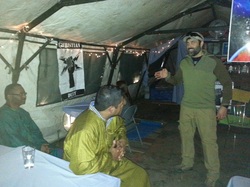
If you follow this blog, you know I've talked a lot about having your own set of RULES that you never break no matter what. Your rules can take many shapes and may vary somewhat depending on your particular job, event, or circumstance. However, one thing that doesn't change is that your RULES must be linked, unmistakably to your core beliefs, values, and/or faith. Your adherence to those rules MUST NOT WAIVER. Lets look at an example from my world: one rule your might have is that "If I see a human rights violation I'm going to do something to stop it". Okay, sounds easy right? Well, it is to some extent, but it can get tricky. The real benefit of having these set RULES in place is that it frees your brain from the question "Should I do something?" (that question has already been answered when you set your RULES) and allows it to go directly to "What should I do?" So if you see a guy roughing up (physically or emotionally) his girlfriend outside a bar, you already know you're going to interdict, too easy, that's your RULE; your brain is now free to consider the 1st, 2nd, & even 3rd order effects of your possible responses and then initiate action. I could go on at length about how incorporating these rules into your training until they become automatic and move out of your pre-frontal cortex can free it up to be in the moment thus allowing you greater mindfulness, situation awareness, and mental agility, but I want look at another example. Lets use an endurance event or even the train up for that event.
So lets use my favorite RULE, "I never quit". As I've said before, these 3 little words got me through the 2012 Spartan Death Race in 60 hours 22 minutes with no real issues. It was my only rule. Now, as I've also said, I had a lot of sub-rules that helped me to not break that main rule, but you can read about that in my other posts. But I will recount just one of many shining examples of how following that rule allowed me to finish, while I watched another crumble & quit right in front of me for no other reason than just ran out of him self. I'm not even sure what hour this took place but it was sometime Saturday night I think...maybe around hour 36ish...Anyways, as a "penalty" for some minor infraction of the rules, a group of us had to go sit in the duck pond for 90 minutes. Now, for those of you who don't know, the DR takes place in Vermont. Although it was June, it was 2 or 3 am and the water was very cold. So anyways, after about 45 minutes of pain (despite my intense use of imagery and amateur Tumo Meditation) the volunteer watching us told us we could get out of the water. I was relieved, but not nearly as much as the guy next to me who was really miserable and complaining the whole time we were in the water (which breaks another one of my sub-rules: never complain or vocalize your misery, it's like a cancer and once you give it power in the form of words, you let it in and it eats away at you until your done). So we get out and it's even colder outside, but as we're trying to get dressed again, the volunteer's radio cracked to life with the race director telling her to put us back in, we were only half done. At that point, I dutifully started to get undressed & get back in the water (there was never a question of IF I should get back in, my RULE had answered that for me already). However, the guy who was next to me said he couldn't do it and was going to quit. I attempted (albeit, half-heartedly) to dissuade him from quitting but he was done. So as he quit, I braced myself for the shock of the cold water and I jumped right back in. I was shocked by the water alright, but not in the way I'd thought. If you've ever gone swimming at night, you've probably guessed what shocked me. It wasn't that the water was so cold, but that it felt so warm. Not to make light of the quitter, but I literally laughed out loud. The only thing he had to do was not quit. That was it. If he had only got back in the water, he would have made the same amazing discovery as me. But he didn't. He quit. He quit not because what he WAS DOING was so horrible, but because the thought of what he was ABOUT TO DO was. My RULES kept me from having to even wrestle with that decision. Would yours?
I saw a lot of shit this week that prompted this post. .. But that's all I'll say about that.
 RSS Feed
RSS Feed